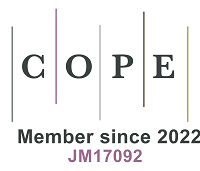REFERENCES
1. He CT, Zheng J, Qiao L, et al. Occurrence of organophosphorus flame retardants in indoor dust in multiple microenvironments of southern China and implications for human exposure. Chemosphere 2015;133:47-52.
2. Wei GL, Li DQ, Zhuo MN, et al. Organophosphorus flame retardants and plasticizers: sources, occurrence, toxicity and human exposure. Environ Pollut 2015;196:29-46.
3. Beth-hübner M. Toxicological evaluation and classification of the genotoxic, carcinogenic, reprotoxic and sensitising potential of tris(2-chloroethyl)phosphate. Int Arch Occup Environ Health 1999;72:M017-23.
4. Andresen JA, Grundmann A, Bester K. Organophosphorus flame retardants and plasticisers in surface waters. Sci Total Environ 2004;332:155-66.
5. Marklund A, Andersson B, Haglund P. Screening of organophosphorus compounds and their distribution in various indoor environments. Chemosphere 2003;53:1137-46.
6. Zhang Y, Li M, Li S, et al. Exposure to tris(1,3-dichloro-2-propyl) phosphate for two generations decreases fecundity of zebrafish at environmentally relevant concentrations. Aquat Toxicol 2018;200:178-87.
7. Zhang Q, Ji C, Yin X, Yan L, Lu M, Zhao M. Thyroid hormone-disrupting activity and ecological risk assessment of phosphorus-containing flame retardants by in vitro, in vivo and in silico approaches. Environ Pollut 2016;210:27-33.
8. Zhang Q, Lu M, Dong X, et al. Potential estrogenic effects of phosphorus-containing flame retardants. Environ Sci Technol 2014;48:6995-7001.
9. He MJ, Lu JF, Ma JY, Wang H, Du XF. Organophosphate esters and phthalate esters in human hair from rural and urban areas, Chongqing, China: Concentrations, composition profiles and sources in comparison to street dust. Environ Pollut 2018;237:143-53.
10. Kucharska A, Cequier E, Thomsen C, Becher G, Covaci A, Voorspoels S. Assessment of human hair as an indicator of exposure to organophosphate flame retardants. Case study on a Norwegian mother-child cohort. Environ Int 2015;83:50-7.
11. Lai S, Xie Z, Song T, et al. Occurrence and dry deposition of organophosphate esters in atmospheric particles over the northern South China Sea. Chemosphere 2015;127:195-200.
12. Kim UJ, Wang Y, Li W, Kannan K. Occurrence of and human exposure to organophosphate flame retardants/plasticizers in indoor air and dust from various microenvironments in the United States. Environ Int 2019;125:342-9.
13. Cao S, Zeng X, Song H, et al. Levels and distributions of organophosphate flame retardants and plasticizers in sediment from Taihu Lake, China. Environ Toxicol Chem 2012;31:1478-84.
14. Li J, Yu N, Zhang B, et al. Occurrence of organophosphate flame retardants in drinking water from China. Water Res 2014;54:53-61.
15. Brandsma SH, Leonards PE, Leslie HA, de Boer J. Tracing organophosphorus and brominated flame retardants and plasticizers in an estuarine food web. Sci Total Environ 2015;505:22-31.
16. Li J, Dong Z, Wang Y, Bao J, Yan Y, Jin J. Different organophosphate flame retardant and metabolite concentrations in urine from male and female university students in Beijing and an assessment of exposure via indoor dust. Environ Toxicol Chem 2019;38:760-8.
17. Han L, Sapozhnikova Y, Nuñez A. Analysis and occurrence of organophosphate esters in meats and fish consumed in the United States. J Agric Food Chem 2019;67:12652-62.
18. Wang Y, Li W, Martínez-Moral MP, Sun H, Kannan K. Metabolites of organophosphate esters in urine from the United States: concentrations, temporal variability, and exposure assessment. Environ Int 2019;122:213-21.
19. Hermanson MH, Johnson GW. Polychlorinated biphenyls in tree bark near a former manufacturing plant in Anniston, Alabama. Chemosphere 2007;68:191-8.
20. Salamova A, Hites RA. Evaluation of tree bark as a passive atmospheric sampler for flame retardants, PCBs, and organochlorine pesticides. Environ Sci Technol 2010;44:6196-201.
21. Peverly AA, Salamova A, Hites RA. Locating POPs Sources with tree bark. Environ Sci Technol 2015;49:13743-8.
22. Simonich SL, Hites RA. Vegetation-atmosphere partitioning of polycyclic aromatic hydrocarbons. Environ Sci Technol 1994;28:939-43.
23. Schulz H, Popp P, Huhn G, Stärk H, Schüürmann G. Biomonitoring of airborne inorganic and organic pollutants by means of pine tree barks. I. Temporal and spatial variations. Science of The Total Environment 1999;232:49-58.
24. Samecka-Cymerman A, Kosior G, Kempers AJ. Comparison of the moss Pleurozium schreberi with needles and bark of Pinus sylvestris as biomonitors of pollution by industry in Stalowa Wola (southeast Poland). Ecotoxicol Environ Saf 2006;65:108-17.
25. Ren G, Chu X, Zhang J, et al. Organophosphate esters in the water, sediments, surface soils, and tree bark surrounding a manufacturing plant in north China. Environ Pollut 2019;246:374-80.
26. Peverly AA, Salamova A, Hites RA. Air is still contaminated 40 years after the Michigan chemical plant disaster in St. Louis, Michigan. Environ Sci Technol 2014;48:11154-60.
27. Cequier E, Ionas AC, Covaci A, Marcé RM, Becher G, Thomsen C. Occurrence of a broad range of legacy and emerging flame retardants in indoor environments in Norway. Environ Sci Technol 2014;48:6827-35.
28. Li W, Wang Y, Asimakopoulos AG, et al. Organophosphate esters in indoor dust from 12 countries: concentrations, composition profiles, and human exposure. Environ Int 2019;133:105178.
29. Shoeib T, Webster GM, Hassan Y, et al. Organophosphate esters in house dust: a comparative study between Canada, Turkey and Egypt. Sci Total Environ 2019;650:193-201.
30. Tao F, Sellström U, de Wit CA. Organohalogenated flame retardants and organophosphate esters in office air and dust from Sweden. Environ Sci Technol 2019;53:2124-33.
31. Hou M, Fang J, Shi Y, et al. Exposure to organophosphate esters in elderly people: Relationships of OPE body burdens with indoor air and dust concentrations and food consumption. Environ Int 2021;157:106803.
32. Tao F, Tan Y, Lu Q, et al. A natural environmental chamber study on the emissions and fate of organophosphate esters in the indoor environment. Sci Total Environ 2022;827:154280.
33. Zhao L, Zhang Y, Deng Y, et al. Traditional and emerging organophosphate esters (OPEs) in indoor dust of Nanjing, eastern China: occurrence, human exposure, and risk assessment. Sci Total Environ 2020;712:136494.
34. Poon S, Wade MG, Aleksa K, et al. Hair as a biomarker of systemic exposure to polybrominated diphenyl ethers. Environ Sci Technol 2014;48:14650-8.
35. Covaci A, Tutudaki M, Tsatsakis AM, Schepens P. Hair analysis: another approach for the assessment of human exposure to selected persistent organochlorine pollutants. Chemosphere 2002;46:413-8.
36. Kucharska A, Covaci A, Vanermen G, Voorspoels S. Development of a broad spectrum method for measuring flame retardants - overcoming the challenges of non-invasive human biomonitoring studies. Anal Bioanal Chem 2014;406:6665-75.
37. Zheng J, Luo XJ, Yuan JG, et al. Levels and sources of brominated flame retardants in human hair from urban, e-waste, and rural areas in South China. Environ Pollut 2011;159:3706-13.
38. Tang L, Lei B, Xu G, et al. Polybrominated diphenyl ethers in human hair from the college environment: comparison with indoor dust. Bull Environ Contam Toxicol 2013;91:377-81.
39. Król S, Namieśnik J, Zabiegała B. Occurrence and levels of polybrominated diphenyl ethers (PBDEs) in house dust and hair samples from Northern Poland; an assessment of human exposure. Chemosphere 2014;110:91-6.
40. Peng FJ, Emond C, Hardy EM, et al. NESCAV project group for the Grand Duchy of Luxembourg. Population-based biomonitoring of exposure to persistent and non-persistent organic pollutants in the Grand Duchy of Luxembourg: results from hair analysis. Environ Int 2021;153:106526.
41. Zheng J, Chen KH, Luo XJ, et al. Polybrominated diphenyl ethers (PBDEs) in paired human hair and serum from e-waste recycling workers: source apportionment of hair PBDEs and relationship between hair and serum. Environ Sci Technol 2014;48:791-6.
42. Lin M, Tang J, Ma S, et al. Insights into biomonitoring of human exposure to polycyclic aromatic hydrocarbons with hair analysis: a case study in e-waste recycling area. Environ Int 2020;136:105432.
43. Chen K, Zheng J, Yan X, et al. Dechlorane plus in paired hair and serum samples from e-waste workers: correlation and differences. Chemosphere 2015;123:43-7.
44. Liu LY, He K, Hites RA, Salamova A. Hair and nails as noninvasive biomarkers of human exposure to brominated and organophosphate flame retardants. Environ Sci Technol 2016;50:3065-73.
45. Qiao L, Zheng XB, Zheng J, et al. Analysis of human hair to assess exposure to organophosphate flame retardants: influence of hair segments and gender differences. Environ Res 2016;148:177-83.
46. Yuan H, Jin J, Bai Y, Li Q, Wang Y, Hu J. Concentrations and distributions of polybrominated diphenyl ethers and novel brominated flame retardants in tree bark and human hair from Yunnan Province, China. Chemosphere 2016;154:319-25.
47. Zhou Y, SunY, Jin J, et al. Levels of polychlorinated biphenyls in Tibetan and Yi adolescents’ hair from Liangshan Prefecture, Sichuan Province. Huan Jing Ke Xue 2015;36:274-9.
48. Kintz P; Salomone A, Vincenti M. Hair Analysis in Clinical and Forensic Toxicology. Available from: https://books.google.com.hk/books?hl=zh-CN&lr=&id=k__IBAAAQBAJ&oi=fnd&pg=PP1&dq=48.+Kintz+P%3B+Salomone+A,+Vincenti+M.+Hair+Analysis+in+Clinical+and+Forensic+Toxicology.+Academic+Press,+2015.&ots=e1f4C645Au&sig=qIsFInCTzHoEqu0lVpn3LIFMUE0&redir_esc=y#v=onepage&q=48.%20Kintz%20P%3B%20Salomone%20A%2C%20Vincenti%20M.%20Hair%20Analysis%20in%20Clinical%20and%20Forensic%20Toxicology.%20Academic%20Press%2C%202015.&f=false [Last accessed on 22 Apr 2022].
49. Ma Y, Jin J, Li P, et al. Organophosphate ester flame retardant concentrations and distributions in serum from inhabitants of Shandong, China, and changes between 2011 and 2015. Environ Toxicol Chem 2017;36:414-21.
50. Dong Z, Ma YL, Li JQ, Yuan HD, Jin J, Wang Y. Occurrence and human exposure risk assessment of organophosphate esters in drinking water in the Weifang Binhai economic-technological development area. Huan Jing Ke Xue 2017;38:4212-9.
51. der Veen I, de Boer J. Phosphorus flame retardants: properties, production, environmental occurrence, toxicity and analysis. Chemosphere 2012;88:1119-53.
52. Björklund J, Isetun S, Nilsson U. Selective determination of organophosphate flame retardants and plasticizers in indoor air by gas chromatography, positive-ion chemical ionization and collision-induced dissociation mass spectrometry. Rapid Commun Mass Spectrom 2004;18:3079-83.
53. World Health Organization. Flame retardants : tris(chloropropyl) phosphate and tris(2- chloroethyl) phosphate. Available from: http://apps.who.int/iris/bitstream/handle/10665/42148/WHO_EHC_209.pdf;jsessionid [Last accessed on 22 Apr 2022].
54. Li P. Study on exposure levels and pathways of persistent organic flame retardants in serum of the general population in typical areas. Beijing: Minzu university of China. 2016.
55. Reemtsma T, Quintana JB, Rodil R, Garcı´a-lópez M, Rodrı´guez I. Organophosphorus flame retardants and plasticizers in water and air I. Occurrence and fate. TrAC Trends in Analytical Chemistry 2008;27:727-37.
56. Cao Z, Xu F, Covaci A, et al. Differences in the seasonal variation of brominated and phosphorus flame retardants in office dust. Environ Int 2014;65:100-6.
57. Fromme H, Lahrz T, Kraft M, et al. Organophosphate flame retardants and plasticizers in the air and dust in German daycare centers and human biomonitoring in visiting children (LUPE 3). Environ Int 2014;71:158-63.
58. IARC. Lead and lead compounds: lead and inorganic lead compounds (Group 2B) organolead compounds (Group 3). Available from: https://www.ncbi.nlm.nih.gov/books/NBK533630/ [Last accessed on 22 Apr 2022].
59. Keimowitz AR, Strunsky N, Wovkulich K. Organophosphate flame retardants in household dust before and after introduction of new furniture. Chemosphere 2016;148:467-72.
60. WHO. Flame retardants : a general introduction. Available from: https://apps.who.int/iris/handle/10665/41961 [Last accessed on 22 Apr 2022].
61. Meng W, Li J, Shen J, Deng Y, Letcher RJ, Su G. Functional group-dependent screening of organophosphate esters (OPEs) and discovery of an abundant OPE bis-(2-ethylhexyl)-phenyl phosphate in indoor dust. Environ Sci Technol 2020;54:4455-64.
62. Wu M, Yu G, Cao Z, et al. Characterization and human exposure assessment of organophosphate flame retardants in indoor dust from several microenvironments of Beijing, China. Chemosphere 2016;150:465-71.
63. Cequier E, Sakhi AK, Marcé RM, Becher G, Thomsen C. Human exposure pathways to organophosphate triesters - a biomonitoring study of mother-child pairs. Environ Int 2015;75:159-65.
64. Takigami H, Suzuki G, Hirai Y, Ishikawa Y, Sunami M, Sakai S. Flame retardants in indoor dust and air of a hotel in Japan. Environ Int 2009;35:688-93.
65. Li J. Study on the status of organic flame retardant in university students of beijing exposed to indoor dust. Beijing: Minzu university of China. 2019.







